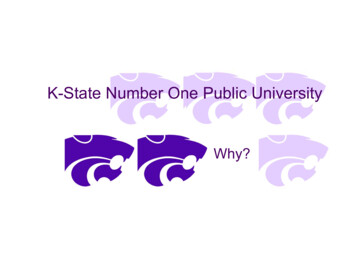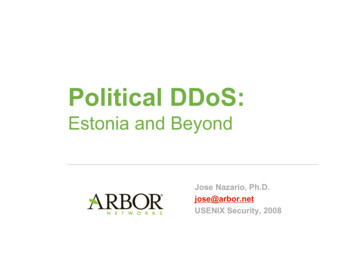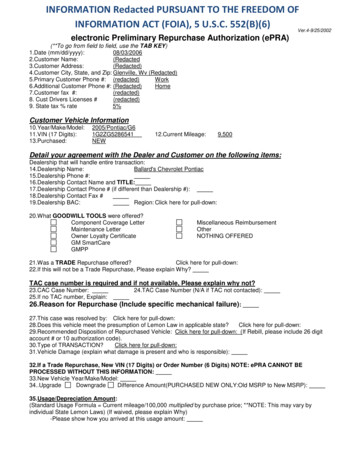
Transcription
CORRELATIONS OF PROPERTY STOCKS WITH OTHER ASSET CLASSESCorrelations ofProperty Stocks withother Asset ClassesBroadening the Investor Base StudyMay 2007
About the authorsProf. Dr. Steffen SEBASTIANProfessor for Real Estate FinanceSteffen Sebastian is Head of the Chair for Real Estate Finance atthe IRE BS International Real Estate Business School, Universityof Regensburg, Germany. Before coming to IRE BS, he gainedconsiderable experience in financial analysis having been employed asan assistant professor at the finance department of Goethe-University,Frankfurt. His research interests are real estate securities, including the importance ofdirect and indirect real estate in the portfolio of institutional investors. Topics includeinflation risk of indirect real estate, bank run risk of open end real estate funds, andindex calculation for direct and indirect real estate investments.Mrs. Melanie SturmResearch AssistantChair of Real Estate FinanceMelanie Sturm is research assistant at the Chair for Real EstateFinance at the IRE BS International Real Estate Business School,University of Regensburg, Germany. She holds a diploma in BusinessAdministration. Her research focus is the risk analysis of stock quotedproperty companies.IRE BS International Real Estate Business SchoolUniversity of Regensburg, Germanymore info: www.irebs.deEuropean Public Real Estate AssociationSchiphol Boulevard 2831118 BH Schiphol AirportThe NetherlandsT 31 (0)20 405 3830F 31 (0)20 405 3840W www.epra.com
contentsTable of Contents1Executive Summary52Data Description93Correlations of Property Stocks with other Asset Correlations with StocksCorrelations with BondsCorrelations with Money / Treasury BondsCorrelations with Emerging Market StocksCorrelations with Direct Real EstateCorrelations with Private Equity and Venture CapitalCorrelations with Private Equity and Buy Outs & MezzanineCorrelations with Hedge Funds and Commoditiescorrelations of propert y stocks with other asset classes- may 2007 - www . epra . com
executive summary1Executive SummaryBackgroundOne good reason to invest in property stocks is profitability, an even better one is diversification.Various studies have shown that integrating property stocks increases significantly the risk-/returnprofile of a mixed asset portfolio - including the recent EPRA-study by Shaun Bond of the Universityof Cambridge. Although, the application of complex optimisation unavoidably means that we haveto make several assumptions about the markets and investors preferences. Those assumptions limitnaturally the validity of the results for all types of investors and/or market conditions. Furthermore,the results, i.e., the weight of property companies in an investor’s portfolio, might vary considerablydepending on the design of the optimization model. All in all, the results of complex optimizationsmodels are difficult to communicate and easy to criticise.EPRA/IRE BS StudyEPRA and IRE BS decided to embark on a detailed study focused on the correlation of propertystocks. The diversification benefits of an investment in property companies depend mainly on thecorrelation with other asset classes, such as stocks or bonds. A closer look at the evolution of thecorrelations over time already gives first insight into the evolution of the diversification potential ofproperty stocks. We hope that this might serve as a reference for both, practitioners and researchers.Furthermore, this study may ignite a broader range of investor interest wishing to examine thediversification benefits of property stocks.In addition to the FTSE EPRA/NAREIT Global Total Return Index and the FTSE EPRA/NAREIT EuropeTotal Return Index we include the FTSE EPRA/NAREIT Indices for USA, UK, Australia, France, Swedenand the Netherlands in our study. We do not consider big economies like Germany, Italy and Spainbecause there are only small real estate stock markets in these countries. For example, for Germany,only 0.64% of total real estate is quoted on the stock market and listed real estate represents only0.45% of the stock market. For Italy and Spain, we observe similar market capitalisations. Here, listedreal estate represents only 0.58% and 1.91% of the stock market, respectively.It is the aim of the EPRA/IRE BS study to illustrate the correlation of property stocks with the largeuniverse of investment opportunities. We have identified three classical asset classes: stocks, bondsand money (treasury bills), and five alternative asset classes, including direct real estate, emergingmarket stocks, hedge funds, private equity and commodities.MethodologyIt must be noted at this point that correlations, as well as diversification potential, are not everlastingcharacteristics of an investment as they can vary significantly over time. The aim of the present studyis to investigate rolling window correlations using periods of 5 years, analysing quarterly returns ofFTSE EPRA/NAREIT Global Real Estate Index series against other asset classes, as defined above. Weare preliminary interested in the correlations of the FTSE EPRA/NAREIT Indices with the asset classesand not the foreign currency. For this purpose, we include the FTSE EPRA/NAREIT Indices in localcurrency and compare national indices (local) wherever possible. Furthermore, we assume, that theinvestor hedge against currency risk in a way which causes no premium payments, i.e. by taking outa zero cost hedge. For the FTSE EPRA/NAREIT Global and Europe we cannot build up a full hedgeposition because they consist of economies with different currencies. The following presents selectedresults of the study.Correlations with stocksFirst results show moderate to strong correlations between the returns of the FTSE EPRA/NAREITIndices and stock returns. For FTSE EPRA/NAREIT US we observe correlations between 0.4 and 0.6and for the FTSE EPRA/NAREIT Global, Europe and UK ranging between 0.6 and 0.8. In the periodof I/94-I/99 the correlations are mostly constant, with the exception of the UK where the correlationsvary temporarily between 0 and 0.2 for the period I/96-I/01, reverting back to similar levels as theother FTSE EPRA/NAREIT Indices in the period I/01-I/06.correlations of propert y stocks with other asset classes- may 2007 - www . epra . com
correlations of property stocks with other asset classesIn earlier periods we observe contrasting patterns. While correlations are heavily positive withEuropean stocks, correlations with US stocks are significantly lower, to the extent that in the periodI/91 - I/96 they actually reach values close to zero.Correlations of the FTSE EPRA/NAREIT for US and Australia with stocks show an inverse behaviour.For FTSE EPRA/NAREIT US, correlations with European stocks reach values close to zero in 91-96while correlations with US stocks remain clearly positive. Correlations of FTSE EPRA/NAREIT Australiaand US stocks are heavily positive for the entire period and they even reach their heaviest extent inthe period III/93-III/98.Correlations with bondsIn contrast, correlations between the FTSE EPRA/NAREIT Indices and Bonds Indices for Germany, UKand USA are not constant over time, decreasing from 1999 till 2006. They are mostly positive until1999; but at the end of 1998 we observe a sharp decline in the correlation figures. From 2000 on,we even find negative correlations (between 0.0 and 0.5). For all FTSE EPRA/NAREIT Indices (exceptAustralia), correlations move in a similar fashion in the observation period. Here, we observe after aperiod of declining values a gradual climb from 2003.For FTSE EPRA/NAREIT Australia we observe continuously the strongest correlations with bonds andthere is no sharp decline in the correlation figure. On the contrary, correlations decline moderatelybut steadily from 1998 till 2003/2004 and reach only minor negative values.Correlations with money/treasury bondsCorrelation of property stock returns with those of treasury bonds show a very interesting evolutionover time. Correlations are negative in 1995-1998, starting with values between -0.5 and -0.2. Allcorrelations rise steadily until 2006, ending with values between 0.3 and 0.6.We find the most stable evolution over time for correlations of FTSE EPRA/NAREIT Australia.Correlations are close to zero until 2002. Only in the following period, we observe increasing volatilityin correlations.Correlations with emerging market stocksAlthough correlations with emerging markets Europe, Asia and Latin America are currently strongpositive for all FTSE EPRA/NAREIT Indices – except FTSE/EPRA NAREIT Australia with moderate valuesbetween 0.3 and 0.4 – we observe contrasting patterns in the considered period from 1995 until2006. While correlations for the FTSE EPRA/NAREIT Global, Netherlands and also Europe are steadilystrong, we observe after a decline in the correlation level even negative correlations for US (about1997), UK (about 2001) and Sweden (about 1998) followed by a constant climb until 2006.Correlations with direct real estateWhile correlations of property stocks with stocks are mostly strong positive especially in later periods,we can not make such a clear declaration about correlations with direct property. For FTSE EPRA/NAREIT France, Netherlands and Sweden correlations vary about zero. For the remaining FTSEEPRA/NAREIT Indices we observe increasing correlations from about 1999 until now. Currently, allcorrelations are positive ranging between 0.15 for Sweden and 0.55 for Australia.Correlations with private equityBecause of the limited history and the bounded representativeness of the index, we only observe thecorrelations in the period from 2000 till 2004. Here, correlations are mostly constant. For the periodI/99-I/04 we find positive correlations of the FTSE EPRA/NAREIT Indices and venture capital Europevarying between 0.1 for the FTSE EPRA/NAREIT Australia and 0.6 for the FTSE EPRA/NAREIT Global.Furthermore, correlations with venture capital Europe are stronger than correlations with venturecapital USA. These correlations vary between clearly negative values for the FTSE EPRA/NAREIT UKand clearly positive values for the FTSE EPRA/NAREIT Global and Sweden. correlations of propert y stocks with other asset classes- may 2007 - www . epra . com
executive summaryOn the contrary, correlations with buyouts & mezzanine USA are notably stronger than correlationswith buyouts & mezzanine Europe. For the period I/99-I/04, we observe correlations between 0.25and 0.56 for the FTSE EPRA/NAREIT Indices with buyouts & mezzanine USA, while correlations withbuyouts & mezzanine Europe vary between -0.4 and 0.2.On average, correlations with the overall (private equity) index are weaker than correlations withventure capital and buyouts & mezzanine USA but stronger than correlations with buyouts &mezzanine Europe.Correlations with hedge fundsCorrelations with Hedge Funds behave similar to correlations with emerging markets. They arealso currently strong positive, and we also observe the most moderate level for FTSE EPRA/NAREITAustralia. Furthermore, correlations of FTSE EPRA/NAREIT Global are remarkable steadily strongwith a mean of 0.76, whereas we find a period of decreasing correlations for US (1996-1998) and UK(2000-2004) and – comparable to the evolution of correlations with emerging markets – a climb inthe following period until 2006.Correlations with commoditiesIn the first periods correlations of property stocks with commodities are mostly negative. Here, wefind on average the lowest correlation level for Australia (correlations between -0.3 and -0.5). In theperiod of 1998/1999 the correlations of all FTSE EPRA/NAREIT Indices increase, but especially for theFTSE EPRA/NAREIT Global, US and Sweden. And so we currently observe positive correlations ofabout 0.2, with the exception that correlations for the FTSE EPRA/NAREIT Australia again decreasefrom I/00-I/05 and are clearly negative at the moment.ConclusionFor all asset classes, we see that property stocks show correlations significantly below 1.0, and insome cases negative readings occur, thus indicating diversification potential for investing in propertystocks. The evolution over time results in the assumption that diversification benefits are most likelyto vary considerably over time. This phenomenon must, among others, be taken into considerationwhen including property stocks in a mixed asset portfolio.correlations of propert y stocks with other asset classes- may 2007 - www . epra . com
data description2Data DescriptionStocksWe use the stock market indices for Europe and the United States provided by Morgan Stanley CapitalInternational (MSCI Indices) to calculate total market returns. The MSCI-Indices exclude capitalarrangements especially dividend payments. According to MSCII the indices cover at least 60 per centof the market capitalisation. The index currency is Euro and US Dollars respectively.Source: DataStreamDataStream Codes:MSCI USA - TOT RETURN IND - MSUSAML(RI)MSCI EUROPE - TOT RETURN IND - MSEROPL(RI)BondsThe bonds indices are DataStream total all lives government bond indices for Germany, USA andUK. The indices include bonds with different liquidity to cover the development of the wholemarket and are calculated following the recommendations of the European Federation of FinancialAnalysts Societies (EFFAS). So capital arrangements especially dividend payments are excluded. TheDataStream indices are investable and replicable. Index currency is USD, GBP or EURO respectively.Source: DataStreamDataStream Codes:BD TOTAL ALL LIVES DS GOVT. INDEX - TOT RETURN IND - ABDGVAL(RI)US TOTAL ALL LIVES DS GOVT. INDEX - TOT RETURN IND - AUSGVAL(RI)UK TOTAL ALL LIVES DS GOVT. INDEX - TOT RETURN IND - AUKGVAL(RI)Money/Treasury bondsAs proxies for an investment in the money market we used the 3 Month Libor (London InterbankOffered Rate) and 3 Month Fibor (Frankfurt Interbank Offered Rate).Source: DataStreamDataStream Codes:UK INTERBANK 3 MONTH (LDN:BBA) – OFFERED RATE - BBGBP3MGERMANY INTERBANK 3 MONTH - OFFERED RATE - FIBOR3MEmerging market stocksThe MSCI Emerging Markets Indices represent stocks of emerging markets. The indices are free floatadjusted market capitalization indices that are designed to measure equity market performance inthe global emerging markets. They exclude capital arrangements especially dividend payments.According to MSCI the indices cover at least 60 per cent of the market capitalisation. We use theMSCI-Total-Return Indices for Asia, Europe and Latin America.Source: DataStreamDataStream Codes:MSCI EM ASIA U - TOT RETURN IND - MSEMFA (RI)MSCI EM EUROPE U - PRICE INDEX – MSEEUR (RI)MSCI EM LATIN AMERICAU - PRICE INDEX - MSEFLA (RI)Direct real estateThe NPI (NCREIF Property Index) represents an investment in US Real Estate. The index includes cashflows and estimated changes in value of aggregated US Funds portfolios. Estimations are updated atleast once a year. The index value is reported quarterly.Source: National Council of Real Estate Investment Fiduciaries – NPI National Returns (www.ncreif.com)correlations of propert y stocks with other asset classes- may 2007 - www . epra . com
correlations of property stocks with other asset classesPrivate equityWe use the Private Equity Indices of Venture Economics. According to the provider these are nonannualised, quarterly calculated time weighted returns. They are composed of the concrete cashflow on the one hand and of estimations of changes in value on the other hand. We use an overallindex consisting of the following indices: Venture Capital USA 5 %, Venture Capital Europe 15 %,Buy Outs USA 20 % and Buy Outs Europe 60 %. Due to the limited history the overall index cannotbe calculated over the entire considered time period. We are only able to calculate correlations from1997 till 2004.Representativeness of the index is bounded at the beginning because it consists only of few projects.However, at the end the index represents a highly diversified portfolio.Because the index is not replicable, adjustments are necessary if the investment does not correspondto the portfolio composition. According to the provider the index excludes management fees butparticularly includes taxes and transaction costs. No further information is available on this.Source: Venture EconomicsHedge fundsThe HFRX Global Hedge Fund Index represents an investment in hedge funds. Index currency is USDollar. According to HFR the index is designed to be representative of the overall composition of thehedge fund universe. It is comprised of eight strategies (convertible arbitrage, merger arbitrage,equity hedge, equity market neutral, relative value arbitrage, event driven, distressed securities andmacro). The strategies are asset weighted based on the distribution of assets in the hedge fundindustry.Funds that stop reporting or shut down are included in the database, so according to the providerthere is no survivorship bias.Source: Credit Suisse First Boston/Tremont (www.hedgeindex.com)CommoditiesThe Reuter’s Commodity Price Index is an arithmetic average of commodity futures prices with monthlyrebalancing. According to the provider, the Reuter’s Commodity Price Index is designed to providetimely and accurate representation of a long-only, broadly diversified investment in commodities.Source: DataStreamDataStream Codes:Reuters Commodities Index - PRICE INDEX - RECMDTY(PI)10correlations of propert y stocks with other asset classes- may 2007 - www . epra . com
correlations with stocks3. Correlations of Property Stocks with other Asset Classes3.1. Correlations with Stocks3.1.1 FTSE EPRA/NAREIT Global Total Return IndexStocks Europe1Stocks 0120022003200420052006YearperiodStocks EuropeStocks USAI/90 - I/950,8690,647I/91 - I/960,8810,347I/92 - I/970,8560,331I/93 - I/980,7520,317I/94 - I/990,7640,760I/95 - I/000,7240,724I/96 - I/010,6440,603I/97 - I/020,6830,638I/98 - I/030,7420,700I/99 - I/040,7740,747I/00 - I/050,7560,665I/01 - I/060,7750,696mean of correlation0,7580,578standard deviation of correlation0,0790,177coefficient of variation of correlation0,1040,307Mean of correlation denotes the average correlation of property stocks and the other asset class in theentire considered period. The mean is obtained by dividing the sum of the correlations in the entireconsidered period by the number of correlations.Standard deviation of correlation is the average dispersion of the correlation from the mean in theentire considered period.The coefficient of variation denotes the ratio “standard deviation of correlation / mean of correlation”.In other words, the coefficient of variation is the standard deviation expressed as a percentage ofthe mean. Consequently, it is a dimensionless number that allows comparison of the variation ofpopulations with different mean values.correlations of propert y stocks with other asset classes- may 2007 - www . epra . com11
correlations of property stocks with other asset classes3.1.2 FTSE EPRA/NAREIT Europe Total Return IndexStocks Europe1Stocks 01Year2002200320042005periodStocks EuropeStocks USAI/90 - I/950,7550,424I/91 - I/960,7130,183I/92 - I/970,7240,290I/93 - I/980,7310,099I/94 - I/990,8750,622I/95 - I/000,6700,474I/96 - I/010,5410,388I/97 - I/020,6270,487I/98 - I/030,6610,505I/99 - I/040,6650,558I/00 - I/050,7950,645I/01 - I/060,8150,673mean of correlation0,7150,433standard deviation of correlation0,1080,186coefficient of variation of correlation0,1500,4292006Mean of correlation denotes the average correlation of property stocks and the other asset class in theentire considered period. The mean is obtained by dividing the sum of the correlations in the entireconsidered period by the number of correlations.Standard deviation of correlation is the average dispersion of the correlation from the mean in theentire considered period.The coefficient of variation denotes the ratio “standard deviation of correlation / mean of correlation”.In other words, the coefficient of variation is the standard deviation expressed as a percentage ofthe mean. Consequently, it is a dimensionless number that allows comparison of the variation ofpopulations with different mean values.12correlations of propert y stocks with other asset classes- may 2007 - www . epra . com
correlations with stocks3.1.3 FTSE EPRA/NAREIT United States Total Return IndexStocks Europe1Stocks 01Year2002200320042005periodStocks EuropeStocks USAI/90 0- I/950,53700,7910I/91 0- I/960,16100,5660I/92 0- I/970,05900,3900I/93 0- I/980,17800,3060I/94 0- I/990,43700,3770I/95 0- I/000,39700,4600I/96 0- I/010,28100,2210I/97 0- I/020,39700,3450I/98 0- I/030,41600,3040I/99 0- I/040,50600,4820I/00 0- I/050,70100,6100I/01 0- I/060,64600,6510mean of correlation0,36100,4350standard deviation of correlation0,22700,1540coefficient of variation of correlation0,62900,35402006Mean of correlation denotes the average correlation of property stocks and the other asset class in theentire considered period. The mean is obtained by dividing the sum of the correlations in the entireconsidered period by the number of correlations.Standard deviation of correlation is the average dispersion of the correlation from the mean in theentire considered period.The coefficient of variation denotes the ratio “standard deviation of correlation / mean of correlation”.In other words, the coefficient of variation is the standard deviation expressed as a percentage ofthe mean. Consequently, it is a dimensionless number that allows comparison of the variation ofpopulations with different mean values.correlations of propert y stocks with other asset classes- may 2007 - www . epra . com13
correlations of property stocks with other asset classes3.1.4 FTSE EPRA/NAREIT Australia Total Return IndexStocks Europe1Stocks 01Year2002200320042005periodStocks EuropeStocks USAI/90 - I/950,4180,447I/91 - I/960,4380,534I/92 - I/970,5690,481I/93 - I/980,5940,625I/94 - I/990,4040,583I/95 - I/000,2320,418I/96 - I/010,2640,384I/97 - I/020,3400,454I/98 - I/030,3790,408I/99 - I/040,3620,325I/00 - I/050,5090,511I/01 - I/060,4790,523mean of correlation0,4060,474standard deviation of correlation0,1080,092coefficient of variation of correlation0,2660,1952006Mean of correlation denotes the average correlation of property stocks and the other asset class in theentire considered period. The mean is obtained by dividing the sum of the correlations in the entireconsidered period by the number of correlations.Standard deviation of correlation is the average dispersion of the correlation from the mean in theentire considered period.The coefficient of variation denotes the ratio “standard deviation of correlation / mean of correlation”.In other words, the coefficient of variation is the standard deviation expressed as a percentage ofthe mean. Consequently, it is a dimensionless number that allows comparison of the variation ofpopulations with different mean values.14correlations of propert y stocks with other asset classes- may 2007 - www . epra . com
correlations with stocks3.1.5 FTSE EPRA/NAREIT United Kingdom Total Return IndexStocks Europe1Stocks 01Year2002200320042005periodStocks EuropeStocks USAI/90 - I/950,6060,492I/91 - I/960,4740,244I/92 - I/970,4630,362I/93 - I/980,4900,102I/94 - I/990,3370,273I/95 - I/000,0300,016I/96 - I/01-0,088-0,190I/97 - I/020,1340,034I/98 - I/030,2880,107I/99 - I/040,5030,383I/00 - I/050,7410,570I/01 - I/060,7640,652mean of correlation0,4010,239standard deviation of correlation0,2610,246coefficient of variation of correlation0,6501,0272006Mean of correlation denotes the average correlation of property stocks and the other asset class in theentire considered period. The mean is obtained by dividing the sum of the correlations in the entireconsidered period by the number of correlations.Standard deviation of correlation is the average dispersion of the correlation from the mean in theentire considered period.The coefficient of variation denotes the ratio “standard deviation of correlation / mean of correlation”.In other words, the coefficient of variation is the standard deviation expressed as a percentage ofthe mean. Consequently, it is a dimensionless number that allows comparison of the variation ofpopulations with different mean values.correlations of propert y stocks with other asset classes- may 2007 - www . epra . com15
correlations of property stocks with other asset classes3.1.6 FTSE EPRA/NAREIT France Total Return IndexStocks Europe1Stocks 20002001YearStocks Europe20022003200420052006Stocks USAI/90 - I/950,7050,407I/91 - I/960,6130,070I/92 - I/970,6730,190I/93 - I/980,674-0,105I/94 - I/990,6930,351I/95 - I/000,5070,164I/96 - I/010,4530,226I/97 - I/020,5370,349I/98 - I/030,6020,479I/99 - I/040,5170,402I/00 - I/050,6670,536I/01 - I/060,6880,527mean of correlation0,6130,290standard deviation of correlation0,1050,186coefficient of variation of correlation0,1710,641Mean of correlation denotes the average correlation of property stocks and the other asset class in theentire considered period. The mean is obtained by dividing the sum of the correlations in the entireconsidered period by the number of correlations.Standard deviation of correlation is the average dispersion of the correlation from the mean in theentire considered period.The coefficient of variation denotes the ratio “standard deviation of correlation / mean of correlation”.In other words, the coefficient of variation is the standard deviation expressed as a percentage ofthe mean. Consequently, it is a dimensionless number that allows comparison of the variation ofpopulations with different mean values.16correlations of propert y stocks with other asset classes- may 2007 - www . epra . com
correlations with stocks3.1.7 FTSE EPRA/NAREIT Netherlands Total Return IndexStocks Europe1Stocks 01Year2002200320042005periodStocks EuropeStocks USAI/90 - I/950,5880,201I/91 - I/960,7240,206I/92 - I/970,7820,243I/93 - I/980,7230,220I/94 - I/990,7200,570I/95 - I/000,6440,589I/96 - I/010,4970,462I/97 - I/020,4650,403I/98 - I/030,4920,379I/99 - I/040,4420,388I/00 - I/050,5130,395I/01 - I/060,5760,461mean of correlation0,5880,368standard deviation of correlation0,1280,143coefficient of variation of correlation0,2180,3892006Mean of correlation denotes the average correlation of property stocks and the other asset class in theentire considered period. The mean is obtained by dividing the sum of the correlations in the entireconsidered period by the number of correlations.Standard deviation of correlation is the average dispersion of the correlation from the mean in theentire considered period.The coefficient of variation denotes the ratio “standard deviation of correlation / mean of correlation”.In other words, the coefficient of variation is the standard deviation expressed as a percentage ofthe mean. Consequently, it is a dimensionless number that allows comparison of the variation ofpopulations with different mean values.correlations of propert y stocks with other asset classes- may 2007 - www . epra . com17
correlations of property stocks with other asset classes3.1.8 FTSE EPRA/NAREIT Sweden Total Return IndexStocks Europe1Stocks 01Year2002200320042005periodStocks EuropeStocks USAI/90 - I/950,4860,145I/91 - I/960,5380,116I/92 - I/970,5160,175I/93 - I/980,1830,021I/94 - I/990,4960,306I/95 - I/000,5420,399I/96 - I/010,3820,228I/97 - I/020,6390,502I/98 - I/030,7300,527I/99 - I/040,8060,622I/00 - I/050,8650,664I/01 - I/060,7770,618mean of correlation0,5820,360standard deviation of correlation0,1790,215coefficient of variation of correlation0,3070,5992006Mean of correlation denotes the average correlation of property stocks and the other asset class in theentire considered period. The mean is obtained by dividing the sum of the correlations in the entireconsidered period by the number of correlations.Standard deviation of correlation is the average dispersion of the correlation from the mean in theentire considered period.The coefficient of variation denotes the ratio “standard deviation of correlation / mean of correlation”.In other words, the coefficient of variation is the standard deviation expressed as a percentage ofthe mean. Consequently, it is a dimensionless number that allows comparison of the variation ofpopulations with different mean values.18correlations of propert y stocks with other asset classes- may 2007 - www . epra . com
correlations with bonds3.2. Correlations with Bonds3.2.1 FTSE EPRA/NAREIT Global Total Return IndexBonds Germany1Bonds UKBonds 01Year2002200320042005periodBonds GermanyBonds UKI/90 - I/950,5750,6310,150I/91 - I/960,4030,594-0,011I/92 - I/970,3290,5120,041I/93 - I/980,4480,5420,145I/94 - I/990,0310,117-0,136I/95 - I/00-0,228-0,176-0,445I/96 - I/01-0,283-0,239-0,477I/97 - I/02-0,427-0,299-0,581I/98 - I/03-0,572-0,531-0,730I/99 - I/04-0,494-0,458-0,630I/00 - I/05-0,363-0,534-0,440I/01 - I/06-0,217-0,273-0,392-0,3162006Bonds USAmean of correlation-0,086-0,029standard deviation of correlation0,3630,4260,275coefficient of variation of correlation-4,205-14,861-0,870Mean of correlation denotes the average correlation of property stocks and the other asset class in theentire considered period. The mean is obtained by dividing the sum of the correlations in the entireconsidered period by the number of correlations.Standard deviation of correlation is the average dispersion of the correlation from the mean in theentire considered period.The coefficient of variat
Professor for Real Estate Finance Steffen Sebastian is Head of the Chair for Real Estate Finance at the IRE BS International Real Estate Business School, University . 3.6 Correlations with Private Equity and Venture Capital 51 3.7 Correlations with Private Equity and Buy Outs & Mezzanine 59 3.8. Correlations with Hedge Funds and Commodities 67



